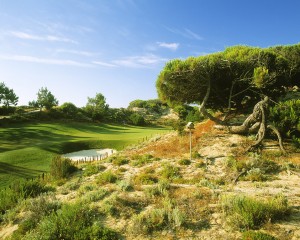
Oitavos Dunes, photo by Aiden Bradley
Grass isn’t the only thing that’s green about golf courses these days. The industry has undertaken tremendous efforts to develop courses that use less water and chemicals, preserve wetlands and forests, protect wildlife, and even reclaim degraded land, such as EPA Superfund sites. Here are nine environmentally responsible layouts that you can feel good about even if you play them badly.
Six Degrees of Turf Management
Two hours east of Kansas City, Colbert Hills Golf Course—designed by tour pro Jim Colbert— is affiliated with Kansas State University so that researchers can directly gauge the effects of golf on the environment in a realistic setting. Students who can’t make the golf team can still earn degrees in turf management. www.colberthills.com.
Pushing the Manila Envelope
Forest Hills Golf and Country Club, east of Manila, is certified by Audubon International as a Cooperative Sanctuary golf course. Certified courses meet required standards for protecting water quality, conserving natural resources, and providing wildlife habitat, among other things. More than 2,110 courses in 24 countries have qualified. Forest Hills includes 18 holes designed by Jack Nicklaus with an added nine by Arnold Palmer. www.golflivingph.com.
Raining Champion or Please Don’t Squeeze the Shaman
Robert Trent Jones II’s The Golf Club at Rainmakers, two hours from Albuquerque, is named to honor a twelfth- century shaman who was responsible for managing the precious commodity of water. The course features a weather station that controls low-distribution sprinkler heads that water only when necessary, and all fairways and greens were treated with a polymer that absorbs, holds, and cools water, thereby requiring 30% less irrigation. www.rainmakersusa.com.
Graphite Shafts
Southeast of Lexington, KY, StoneCrest Golf Course is built on the former site of a vast strip coal mine. Though the mountaintop was cleared of all vegetation and blasted away during mining days, today you can blast a driver off the tees of this links-style muni and dig deep for pars among 50 bunkers and five ponds. www.stonecrestprestonburg.com.
Family Planning
At Oitavos Dunes, outside Lisbon, Arthur Hills/Steve Forrest helped create the first Audubon Certified Gold Sanctuary golf course outside the US, on land owned by the Champalimaud family for generations. The architects protected forests of umbrella pines, rolling dunes, and coastal transition areas, and no buildings will ever block the ocean views from this course that is as charming and challenging as it is natural. www.quintadamarinha-oitavosgolfe.pt.
Firing at the Pin
Just up Lake Michigan from Milwaukee, Whistling Straits Golf Course sits atop an abandoned military base. Pete Dye created this windswept links venue by shaping the entire topography out of imported sand. The course was good enough to host the PGA Championship. www.destinationkohler.com.
Dry Idea
Several hours south of San Diego or north of Loreto on Mexico’s Baja Peninsula, Las Caras de Mexico Golf Course is part of an eco development that features 3,000 solar lots, straw bale house construction, and other environmental features. Located in an area with three inches of rainfall per year, the golf course uses a salt-tolerant hybrid grass that can be watered from brackish wells. 17,500 acres are also managed as green space. www.lascarasdemexico.com.
The Green Course—Literally
Most golfers know the Black Course at New York’s Bethpage State Park (two hours east of Manhattan) as a host of the US Open. But this world-class municipal facility’s Green Course—designed in 1928 by Devereux Emmett—is even greener now. Management is currently experimenting on the putting surfaces to determine whether they can be maintained to playable standards with smaller amounts of chemicals, or none at all. www.nysparks.state.ny.us/golf/.
To the Manoir Born
Two hours east of Quebec, Fairmont’s Manoir Richelieu Golf Club is proof that a luxury brand can operate with an environmental ethic. With 18 holes designed by Herbert Strong in 1925, and nine more added recently by Darrell Huxham, the Manoir courses are part of Fairmont’s Green Partnership Program. You’ll also see blue here: the sparkling blue of the St. Lawrence River, which the golf holes seem to plunge into via dramatic elevation changes. www.fairmontgolf.com.
